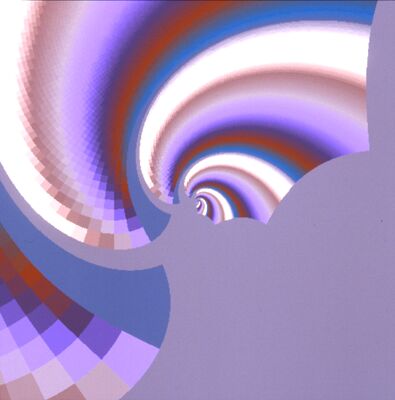Herbert Franke, in collaboration with Horst Helbig
"Complex Transformation"
Digital print, completed in 1990.

Herbert Franke's activities of electronic art began in the year 1956 with the series 'Oszillogramme', and he has continued working in this field. Franke also written widely on computer art and one of his books, 'Computer Graphics - Computer Art', was the earliest comprehensive text on the subject. Franke has collaborated with colleague Horst Helbig in some artworks and essays.
Franke is one of the very earliest pioneers in the use of
electronics in image-making. Primarily a physician and researcher, his
lifelong investigation into the visual possibilities of emerging computer
technologies as they became available make him a seminal figure in the
history of the discipline.
"Mathematical relations can be described alternatively with the help of formulas as with the help of pictures. The practical use of the graphic description has become possible with help of the methods of computer graphics. The mathematical basis of the picture selected for this exhibition is the theory of complex numbers. Complex transformations lead to typical graphic structures, especially modifications of spiral graphs.
"In the time between 1980 and 1992 I have had the possibility to work together with my friend Horst Helbig with a (in that time) very progressive computer system for picture processing and transformation, named DIBIAS. Our goal was the visualisation of mathematics from the point of view of aesthetic effects.
"The artistic use of computer graphics is not the most important, but the most interesting purpose of digital systems. Here is the field to prove new
ideas and to introduce new methods. The occupation with the new instrument in an experimental way opens possibilities of expression in an unconventional manner, and the results are of high value both in art as well as in more practically orientated regions. This is one of the facets of digital graphics: a bridge between art, technology, science - and daily life.
"When I started my first attempts with computer graphic systems to discover the unknown territory of its artistic utilization, I had to deal with geometric elements and arithmetic curves, and the results seemed simple and primitive. It was more the new way of approach than the results itselves, that let hope for an evolution running in the direction for becoming a general tool of visual arts - and arts in general.
"Nowadays, it is easy to see the straight progress, and in this situation the negative criticism coming from conventionally orientated art historians, being a strong obstacle in these old days, has become past.
"I was working with programmed and instrumental visual art, beginning in the Fifties, and I was going the way from analogous to digital computing, from mechanical plotters to the screen with high resolution and a large colour palette, from two to three dimensions and even to animation; but still today I am feeling the fascination for the new type of visual art. The perfection of a technique during a period of only forty
years seems incredible, but taking a look at my several hundreds of pictures from 1956 until 1998 gives the impression not only of an artistic but also of a scientific progress. Still nobody should forget that also now the development of computer systems is not finished, and that means, that also the visual computer art is staying in a process of exploring and expanding. Exactly this situation lets computer graphic activities stay as much a challenge for creativity, as in all the years before."
For more information see the homepage of Herbert W. Franke ( www.herbert-w-franke.de), especially the list of books and the 'Gallery'.

